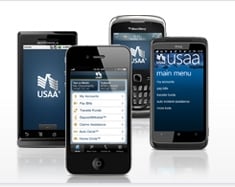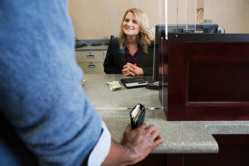I have been a USAA customer for close to 20 years now. When I first started banking with USAA, I had to mail checks into their HQ, which is located in San Antonio, TX. The turnaround time between depositing a check via mail and the time the check was credited to my bank account could be anywhere from a few days to well over a week, depending on when the check was mailed, and from where.
Thankfully, USAA has done a lot to improve the process of depositing checks. In fact, USAA pioneered the digital check deposit process, first with checks that were scanned and uploaded to a secured platform on the USAA website (Deposit @ Home), and later with Deposit @ Mobile, which allows users to simply log into their USAA app on their smartphone or tablet, snap a photo of the front and back of the signed and endorsed check, and deposit the check to their bank account.
This is an incredibly easy and smooth process. And in many cases, the check, or at least a portion of it, is available immediately.
USAA Deposit @ Mobile has revolutionized the way I and hundreds of thousands of their customers do their banking. The same process has also been adopted by countless other banks that now offer check deposits via their smartphone and tablet apps.
How Deposit @ Mobile Works
The first thing you need to do is download the USAA app to your smartphone or tablet. I currently use an Android phone, but the process works the same across Android an Apple (iOS) devices.
USAA Android App

The Android app is a great way to access your USAA account while at home or on the go. In fact, I currently use the app to access my USAA account more frequently than booting up my computer.
It’s faster and the app is streamlined, giving users the ability to access their general account, pay bills, transfer funds, start an insurance claim, access USAA Auto Circle and USAA Home Circle, and my new favorite, USAA Deposit@Mobile, which gives you the ability to deposit a check with your cell phone.
USAA Deposit@Mobile on Android
USAA already offers this feature for home computers under the name Deposit@Home. The premise is the same. With the home version, you scan the front and back your check (after you endorse it with your signature and account number). Then you send the scanned photo and amount of the check and the USAA software verifies the information on the check and deposits it into your account. The process is quick and much faster than mailing the check to USAA, since the funds are usually available the same day.
But believe it or not, USAA Deposit@Mobile is even faster and easier than Deposit@Home since it basically removes a step from the process. Instead of having to scan the check, then save and upload the photo to your USAA account, you simply take a picture of the front of your check, then endorse the back of the check, take another picture, then click submit. USAA then informs you whether or not the picture quality was good enough and whether or not it was accepted.
The first time I tried I didn’t have the check on a dark background and I had to take another picture (this was clearly stated in the instructions. I just used a medium color background). I didn’t have any troubles after I switched to a dark background.
What to Do With the Check After You Deposit via a Mobile App
Once your deposit is accepted you will receive a confirmation number and your funds will be available to you. Users are also instructed to write VOID across the front of the check, using large lettering, or to destroy the check.
I usually write the confirmation number in small letters on the bottom of the front of the check, then wait a few weeks to verify there were no issues with the deposit. Every few weeks, I will destroy the checks to ensure there aren’t any old checks lying around. That could become a security issue, since checks contain the check writer’s bank account number, name, and address.
Here is the main difference between USAA Deposit@Mobile and Deposit@Home: with Deposit@Home you will have a digital copy of your check. It’s probably a good idea to keep a copy of these for your records. With USAA Deposit@Mobile, your phone doesn’t keep a record of the photo. Since the photo isn’t stored, you need to either take another photo, scan it into your computer, or keep a physical copy if you want to maintain a copy for your records.
USAA Deposit @ Mobile Eligibility:
A couple of notes about USAA Deposit@Mobile and Deposit@Home: Not all USAA members are eligible for Deposit@Home and Deposit@Mobile. You must have a USAA checking or savings account and:
- Have an active USAA property and casualty insurance policy and be qualified for a USAA loan or credit card (not a USAA Secured Card), OR
- Be eligible for USAA property and casualty insurance and have an active USAA loan or credit card (not a USAA Secured Card).
Daily Deposit Limits
Contact USAA to verify your eligibility, as well as your daily deposit limit. Most daily deposit limits start small. But they may increase over time, based on the number and type of accounts you have with USAA, your credit history and history with USAA, and other factors.
I have heard of some people being able to deposit up to $100,000 per day. However, there may be a hold placed on a portion of the funds for larger deposits. In addition, I do not believe a $100,000 daily deposit limit is the standard. For larger deposits, you would most likely need to do an ACH or wire transfer.
Supporting Hardware
In addition to meeting eligibility requirements, you will need to have an iPhone or iPad, or an Android capable phone or tablet with the right hardware.
You can download the USAA apps here:
USAA also offers apps for the iPad, Windows 10, Blackberry, and other platforms.
Overall, I’m more than pleased with the USAA Android App, and I’m seriously loving the Deposit@Mobile feature. It simplifies my banking life and makes my money available to me more quickly. Win-win-win.



About the comments on this site:
These responses are not provided or commissioned by the bank advertiser. Responses have not been reviewed, approved or otherwise endorsed by the bank advertiser. It is not the bank advertiser’s responsibility to ensure all posts and/or questions are answered.